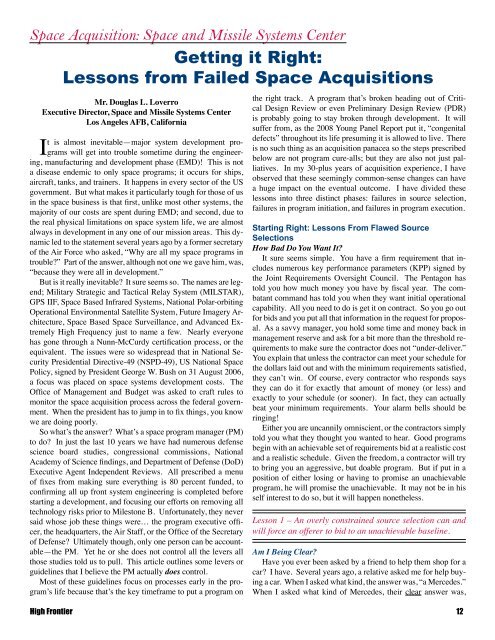Space Acquisition - Air Force Space Command
Space Acquisition - Air Force Space Command
Space Acquisition - Air Force Space Command
You also want an ePaper? Increase the reach of your titles
YUMPU automatically turns print PDFs into web optimized ePapers that Google loves.
<strong>Space</strong> <strong>Acquisition</strong>: <strong>Space</strong> and Missile Systems Center<br />
Getting it Right:<br />
Lessons from Failed <strong>Space</strong> <strong>Acquisition</strong>s<br />
Mr. Douglas L. Loverro<br />
Executive Director, <strong>Space</strong> and Missile Systems Center<br />
Los Angeles AFB, California<br />
It is almost inevitable—major system development programs<br />
will get into trouble sometime during the engineering,<br />
manufacturing and development phase (EMD)! This is not<br />
a disease endemic to only space programs; it occurs for ships,<br />
aircraft, tanks, and trainers. It happens in every sector of the US<br />
government. But what makes it particularly tough for those of us<br />
in the space business is that first, unlike most other systems, the<br />
majority of our costs are spent during EMD; and second, due to<br />
the real physical limitations on space system life, we are almost<br />
always in development in any one of our mission areas. This dynamic<br />
led to the statement several years ago by a former secretary<br />
of the <strong>Air</strong> <strong>Force</strong> who asked, “Why are all my space programs in<br />
trouble” Part of the answer, although not one we gave him, was,<br />
“because they were all in development.”<br />
But is it really inevitable It sure seems so. The names are legend;<br />
Military Strategic and Tactical Relay System (MILSTAR),<br />
GPS IIF, <strong>Space</strong> Based Infrared Systems, National Polar-orbiting<br />
Operational Environmental Satellite System, Future Imagery Architecture,<br />
<strong>Space</strong> Based <strong>Space</strong> Surveillance, and Advanced Extremely<br />
High Frequency just to name a few. Nearly everyone<br />
has gone through a Nunn-McCurdy certification process, or the<br />
equivalent. The issues were so widespread that in National Security<br />
Presidential Directive-49 (NSPD-49), US National <strong>Space</strong><br />
Policy, signed by President George W. Bush on 31 August 2006,<br />
a focus was placed on space systems development costs. The<br />
Office of Management and Budget was asked to craft rules to<br />
monitor the space acquisition process across the federal government.<br />
When the president has to jump in to fix things, you know<br />
we are doing poorly.<br />
So what’s the answer What’s a space program manager (PM)<br />
to do In just the last 10 years we have had numerous defense<br />
science board studies, congressional commissions, National<br />
Academy of Science findings, and Department of Defense (DoD)<br />
Executive Agent Independent Reviews. All prescribed a menu<br />
of fixes from making sure everything is 80 percent funded, to<br />
confirming all up front system engineering is completed before<br />
starting a development, and focusing our efforts on removing all<br />
technology risks prior to Milestone B. Unfortunately, they never<br />
said whose job these things were… the program executive officer,<br />
the headquarters, the <strong>Air</strong> Staff, or the Office of the Secretary<br />
of Defense Ultimately though, only one person can be accountable—the<br />
PM. Yet he or she does not control all the levers all<br />
those studies told us to pull. This article outlines some levers or<br />
guidelines that I believe the PM actually does control.<br />
Most of these guidelines focus on processes early in the program’s<br />
life because that’s the key timeframe to put a program on<br />
the right track. A program that’s broken heading out of Critical<br />
Design Review or even Preliminary Design Review (PDR)<br />
is probably going to stay broken through development. It will<br />
suffer from, as the 2008 Young Panel Report put it, “congenital<br />
defects” throughout its life presuming it is allowed to live. There<br />
is no such thing as an acquisition panacea so the steps prescribed<br />
below are not program cure-alls; but they are also not just palliatives.<br />
In my 30-plus years of acquisition experience, I have<br />
observed that these seemingly common-sense changes can have<br />
a huge impact on the eventual outcome. I have divided these<br />
lessons into three distinct phases: failures in source selection,<br />
failures in program initiation, and failures in program execution.<br />
Starting Right: Lessons From Flawed Source<br />
Selections<br />
How Bad Do You Want It<br />
It sure seems simple. You have a firm requirement that includes<br />
numerous key performance parameters (KPP) signed by<br />
the Joint Requirements Oversight Council. The Pentagon has<br />
told you how much money you have by fiscal year. The combatant<br />
command has told you when they want initial operational<br />
capability. All you need to do is get it on contract. So you go out<br />
for bids and you put all that information in the request for proposal.<br />
As a savvy manager, you hold some time and money back in<br />
management reserve and ask for a bit more than the threshold requirements<br />
to make sure the contractor does not “under-deliver.”<br />
You explain that unless the contractor can meet your schedule for<br />
the dollars laid out and with the minimum requirements satisfied,<br />
they can’t win. Of course, every contractor who responds says<br />
they can do it for exactly that amount of money (or less) and<br />
exactly to your schedule (or sooner). In fact, they can actually<br />
beat your minimum requirements. Your alarm bells should be<br />
ringing!<br />
Either you are uncannily omniscient, or the contractors simply<br />
told you what they thought you wanted to hear. Good programs<br />
begin with an achievable set of requirements bid at a realistic cost<br />
and a realistic schedule. Given the freedom, a contractor will try<br />
to bring you an aggressive, but doable program. But if put in a<br />
position of either losing or having to promise an unachievable<br />
program, he will promise the unachievable. It may not be in his<br />
self interest to do so, but it will happen nonetheless.<br />
Lesson 1 – An overly constrained source selection can and<br />
will force an offerer to bid to an unachievable baseline.<br />
Am I Being Clear<br />
Have you ever been asked by a friend to help them shop for a<br />
car I have. Several years ago, a relative asked me for help buying<br />
a car. When I asked what kind, the answer was, “a Mercedes.”<br />
When I asked what kind of Mercedes, their clear answer was,<br />
High Frontier 12











